|
Please
click on each image to see a larger view!
|
|
|
|
The
class goes like this:
You
meet everyone in class and the instructor puts you
in the Haaglund. Then he takes off really fast and
jars your body as he drives through town. The noise
inside the Haaglund is incredibly loud. You are
given ear plugs before you get in. As we go out
of town and onto the sea ice, we drive over some
cracks. Everyone gets out and looks at the crack.
The instructor takes a shovel out and digs down
through the snow until there is nothing but ice
on the ground beneath. When you look down, you see
a stair case going downward, until it reaches another
staircase going upwards. These steps are the cracks
re-heeling. You have a crack, then the shift and
then you have an opening. The water that comes up
through the crack, then freezes again, this time
at a lower level. This all happens again and again
and again. This becomes really dangerous for traffic
over the sea ice. Where you have these stairs or
multiple cracks, the ice becomes thin. So you use
a drill. You drill down through the ice until you
reach water and measure the thickness of the ice.
The crack can be no larger than 1/3 the track length
of your vehicle. Most of the vehicles that travel
on the sea ice have tracks, like tank tracks.
|
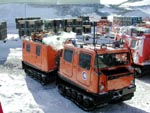 |
This
is a picture of the Aquatic Swiss made vehicle used
here to go out on the sea ice. It is called a Haaglund.
|
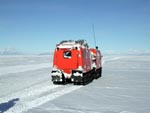 |
Another
look at the Haaglund from the back as we're out
on the sea ice.
|
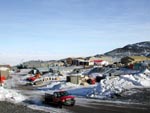 |
A
look back at McMurdo from the sea ice. By the way,
the planes land on the sea ice now until it becomes
too thin. Its about 2 meters thick now. Later in
December, the Ice will be to weak for the planes
to land on. Then the airstrip is moved out to Willy
Field where the TopHat lab is. I think the sea ice
is used as a runway for the airplanes now because
its a lot closer to McMurdo than Willy Field is.
|
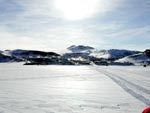 |
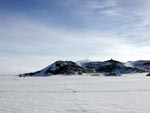 |
Two
more looks at McMurdo from the sea ice.
|
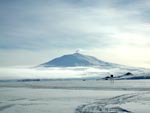 |
Erebus
on a clear day on the sea ice.
|
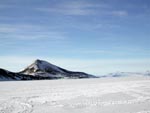 |
View
from the instructors hut out on the sea ice.
|
|
We
learned all that stuff, how to anchor a tent on
the ice and how to survive out on the sea ice.
I
also was talking to this guy here (at McMurdo).
He said that an ice breaker will come in around
December and crack the sea ice. Then ships can come
in with cargo and take waste out. All the waste
here is shipped back to Washington state, USA. They
recycle 70% of what is brought down here for use.
I learned this in the waste management training
class I had to take.
Also
they break the sea ice up because you want new fresh
ice for the planes to land on each year. The old
ice cracks and gets bumpy.
|
|
(TOP)
(Antarctica Images)
(Reports from the
Field)
|